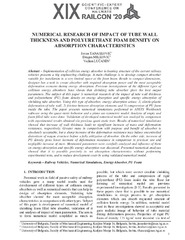Приказ основних података о документу
Numerical research of impact of tube wall thickness and polyurethane foam density on absorption characteristics
| dc.creator | Tanasković, Jovan | |
| dc.creator | Milković, Dragan | |
| dc.creator | Lučanin, Vojkan | |
| dc.date.accessioned | 2023-03-10T20:10:51Z | |
| dc.date.available | 2023-03-10T20:10:51Z | |
| dc.date.issued | 2020 | |
| dc.identifier.isbn | 978-86-6055-134-6 | |
| dc.identifier.uri | https://machinery.mas.bg.ac.rs/handle/123456789/5715 | |
| dc.description.abstract | Implementation of collision energy absorber in bearing structure of the current railway vehicles presents a big engineering challenge. A main challenge is to develop compact absorber suitable for installation in a very limited space at the front beam. Beside to compact dimensions, designer has a task to create absorber with required absorption power and the most acceptable deformation scenario during energy absorption. Previous investigations of the different types of collision energy absorbers have shown that shrinking tube absorber gives the best output parameters. The subject of this paper is numerical research of the impact of tube wall thickness and polyurethane (PU) foam density on energy absorption and specific energy absorption of shrinking tube absorber. Using this type of absorber, energy absorption arises: 1) elastic-plastic deformation of tube wall, 2) friction between absorption elements and 3) compression of PU foam inside the tube. The paper presents numerical simulations performed in ANSYS Workbench software using the quasi-static behavior and a plane axi-symmetric model. Analysis of empty and foam filled tube were done. Validation of developed numerical model was realized by comparison with experimental results obtained via previous quasi-static tests. Results of numerical simulations showed that increase of wall thickness leads to significant increase of mass and deformation resistance, respectively. Greater mass in comparison with purpose and benefit of absorber is absolutely acceptable, but a sharp increase of the deformation resistance may induce uncontrolled distortions of wagon structure before a fully utilization of absorber. On the other side, increase of PU density gives lower increase of deformation resistance in comparison to previous one and negligible increase of mass. Mentioned parameters were carefully analyzed and influence of them on energy absorption and specific energy absorption was discussed. Presented numerical analyses showed that it is possible precisely to set absorption characteristics without performing experimental tests, and to reduce development costs by using validated numerical model | sr |
| dc.language.iso | en | sr |
| dc.publisher | University of Niš, Faculty of Mechanical Engineering | sr |
| dc.relation | info:eu-repo/grantAgreement/MESTD/inst-2020/200105/RS// | sr |
| dc.rights | openAccess | sr |
| dc.source | XIX Scientific-Expert Conference on Railways - RAILCON '20, Proceedings | sr |
| dc.subject | Railway Vehicles | sr |
| dc.subject | Numerical Simulations | sr |
| dc.subject | Energy Absorber | sr |
| dc.subject | PU Foam | sr |
| dc.title | Numerical research of impact of tube wall thickness and polyurethane foam density on absorption characteristics | sr |
| dc.type | conferenceObject | sr |
| dc.rights.license | ARR | sr |
| dc.citation.epage | 8 | |
| dc.citation.rank | M33 | |
| dc.citation.spage | 5 | |
| dc.identifier.fulltext | http://machinery.mas.bg.ac.rs/bitstream/id/13989/Railcon_20_1.pdf | |
| dc.identifier.rcub | https://hdl.handle.net/21.15107/rcub_machinery_5715 | |
| dc.type.version | publishedVersion | sr |


